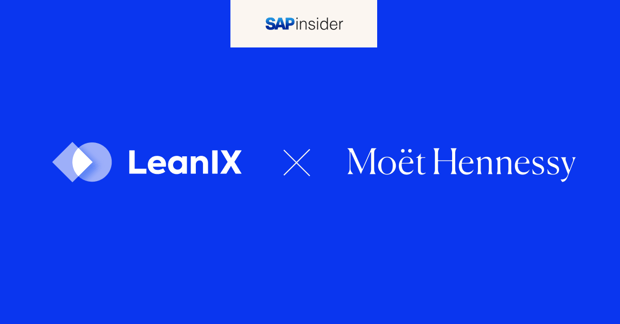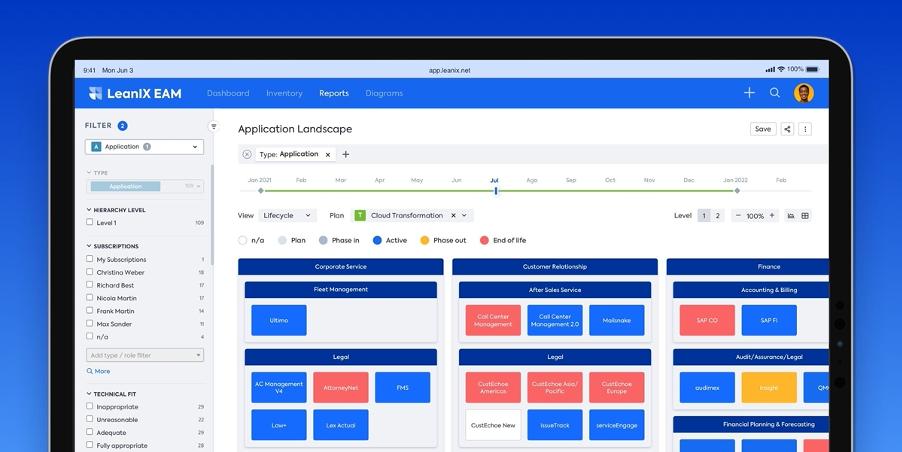
ERP transformation is best driven by enterprise architecture to ensure you retain control, transparency, and collaboration. Let's look at six ERP transformation tips from our customer, Moët Hennessy.
One of the most comprehensive and challenging initiatives an organization can undergo is an enterprise resource planning (ERP) transformation. We believe enterprise architects are best placed to drive ERP transformation, and our customer, Moët Hennessy agrees.
To learn more, watch an on-demand recording of the recent SAP Insider webinar we did with Moët Hennessy or see below for a summary of the six tips on ERP transformation offered during the webinar.
WATCH:
How Moet Hennessy Leverages Enterprise Architecture as a Key Enabler for its SAP S/4HANA Transformation
ERP Transformation Tip 1:
Define The Value You Want To Deliver
"First, we consider... the key element of decision to engage in that journey... To understand where we start from, what is our current landscape and what is the impact? What is the magnitude of the migration?"
Vincent Blondel, Group EA, Moët Hennessy
Moët Hennessy (MH) is the wines and spirits division of the Paris-headquartered LVMH luxury goods specialist. The company has a long value chain from vineyard to retailer across the globe.
MH has set itself a detailed goal of increasing production and diversifying the way it addresses its customers. To do this, it aims to pursue an active mergers and acquisitions (M&A) strategy.
To both enhance its production and logistics, and support technology mergers, MH decided on ERP transformation. From their two legacy instances of SAP ECC Chorus/Cocktail, the company plans to migrate to a single instance of SAP S/4HANA.
The legacy instances are both:
- more than 15 years old
- have over 130 applications connected
- serve 3,200 users
The final switch to SAP S/4HANA is targeted for early 2024. This means the company is just in the preparation phase right now, but they have their work cut out for them.
Chosen to manage this process was the Moët Hennessy enterprise architecture team, led by Group Enterprise Architect, Vincent Blondel. This was due to the architectural complexity of the legacy ERP solutions.
The first step for MH was to choose a "smart brownfield" approach. This focused on cleansing master data and reducing historical data to create a customer-tailored transition that ensured continuity of service.

As an implementation tool, Vincent chose LeanIX EAM because of three key capabilities the EAM has:
- Capitalization and knowledge management
- Repository feed and contributions
- Ability to leverage data to secure the transformation plan
With this clear definition of what they were attempting to achieve, MH was ready to consider how they were going to start the process.
ERP Transformation Tip 2:
Think Big, Start Small, Iterate
"I'm fully convinced that you have to start the journey at the beginning, with the top architecture and the tool implementation... We have to define where we start from, which is really key to... secure that transition.
Vincent Blondel, Group EA, Moët Hennessy
For Vincent, the key to ERP transformation is to have a huge vision for revolutionary change. Then, you have to start with a tiny step towards it and gradually progress forward.
This methodology is the best way to achieve big results, while keeping the workload manageable. Yet, you don't have to re-invent the wheel.
Once they had defined the value they wanted to deliver, Vincent's team looked at their current ERP architecture to see what didn't need to change, and what couldn't. From there, they built around those aspects that would be migrated to SAP S/4HANA to create their complete target architecture, based on their initial vision.
Now the target state is defined, it's a simple matter to roadmap your way from where you are to where you want to be. What's key, however, is maintaining control of that process.
ERP Transformation Tip 3:
Keep Ownership
Without careful control of your ERP transformation process, it's likely to diverge from your planned course and fail to meet your targets. Yet, you can't maintain control without the consent of the governed.
Keeping ownership of your ERP transformation comes from having buy-in from your stakeholders. Vincent is using LeanIX EAM as a single source of truth to align stakeholders to the vision and roadmap.
To find out more about how LeanIX EAM can support your ERP transformation efforts, download our free whitepaper:
DOWNLOAD:
Getting It Right - A Holistic Approach To SAP S/4HANA Transformations
He also enabled a thriving enterprise architecture community across Moët Hennessy (MH). This served to educate potential stakeholders across MH on the purpose and value of enterprise architecture and the progress of their ERP transformation.
ERP Transformation Tip 4:
Organization And Governance First
With stakeholder buy-in at an acceptable level, it was time for Vincent's team to enshrine adherence to their roadmap with governance. This offered clarity to stakeholders on how they could support the ERP transformation initiative and also continues to block any unwelcome surprises.
Organized governance requires careful documentation of all the project information. An information repository serves to co-ordinate the initiative and also offers transparency to stakeholders while keeping ERP transformation top-of-mind.
Comprehensive documentation, however, is a challenge for Moët Hennessy (MH), due to the sheer size of their organization and the length of their value chain. MH has a huge number of ERP stakeholders spread across many levels.
In the past, MH has fully documented important transformation information in spreadsheets that were lost as soon as the project was completed. That's why the company has ensured this ERP transformation's data has been logged safely in LeanIX EAM for future reference.
ERP Transformation Tip 5:
Take A Data-Driven Approach
Basing your initiative on clear documentation also allows a data-driven ERP transformation. This ensures you're making the right decisions and empowers you to back up those choices with facts when stakeholders query them.
Since the decision had been made to cleanse master data and remove historical data, a data governance model was vital for Moët Hennessy (MH). Information ownership has now been clarified at MH, and it was key to educate information owners on the need to preserve essential data in LeanIX EAM, rather than discarding it in a rogue spreadsheet.
The team began by mapping their applications against the software's business capabilities, what it does, who uses it, and who is the owner. That was the "data MVP" (minimum viable product) for MH's LeanIX EAM data repository.
Vincent's team is now working to expand on the data they store in LeanIX EAM. They're adding technical information for all applications, such as components, integrations and, soon, interfaces.
LeanIX EAM's out-of-the-box integrations are key here. MH has ensured their repository is working with: SAP Signavio Servicenow Confluence Jira Collibra and other data sources
ERP Transformation Tip 6:
Make Data Quality A Never-Ending Story
The Collibra data intelligence platform, particularly, is key for maintaining and expanding the quality of Moët Hennessy's (MH) data here. It's also important to ensure data is aligned with the overall business strategy to prevent it from becoming too bloated.
With a disciplined approach to data quality, MH will never again end up in a position where their ERP efficiency is blocked by too much unnecessary legacy data. Yet, this requires constant vigilance on data quality.
Despite this discipline, Vincent's team chose to keep a level of flexibility to their meta model. Agility is key, in Vincent's view, to a successful transformation, so the capabilities of LeanIX EAM were vital for adapting their roadmap as they progressed.
What's Next For Moët Hennessy
Vincent commends LeanIX EAM on both its ability to maintain data quality and its general ease of use. It took just six months to onboard and train Moët Hennessy's (MH) people, and also to run through a data quality review.
Now, the MH EAM repository in LeanIX EAM oversees:
- over 800 applications
- more than 400 business capabilities
- 250+ IT components
The next steps for MH are to add interfaces to the repository and to fully understand the long-term impact of the initiative. This is a challenge, but will be essential for the coming ERP transformation to SAP S/4HANA.
To find out more about how LeanIX EAM can support your ERP transformation efforts, particularly to SAP S/4HANA, download our free whitepaper:



